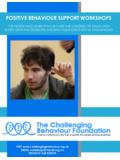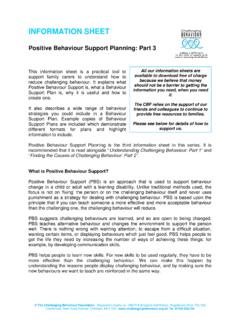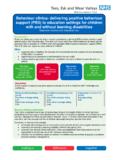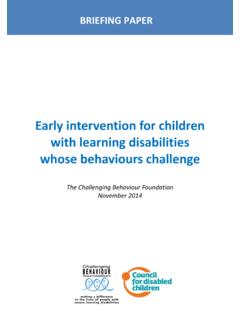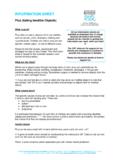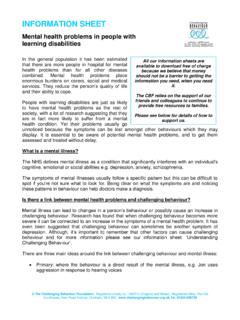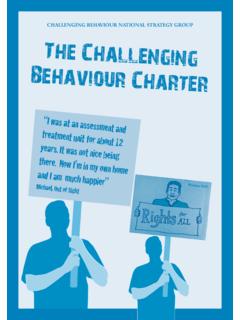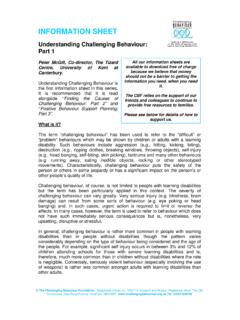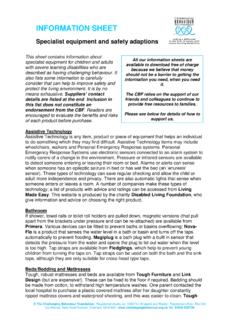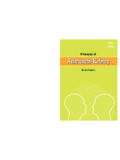Transcription of APPENDIX D TWO EXAMPLES OF POSITIVE …
1 APPENDIX D TWO EXAMPLES OF POSITIVE behavioural support REPORTS These independent reports by a certified behaviour analyst / POSITIVE behavioural support expert were requested by a commissioning care manager within the CBF s personalisation project The aim was to advise the care manager as to whether the commissioned services are delivering the sought outcomes whether the services can be helped to deliver improved outcomes The aim of sharing the reports is to demonstrate how detailed such independent reports can be and how they can be useful to a commissioning care manager It can be seen that the reports highlight which aspects of a service are working well/not working well for the person provide constructive information to enable improvement would be very useful in commissioning a new service report 1: BEHAVIOUR support FOR MR ANDREW SMITH (PSEUDONYM) Based on one visit to his care home and t/c discussion with his care manager Contents 1.
2 Assessment methods: 2. General observations: 3. All about A 4. Defining The Behaviour a. Triggers: b. Course of behaviour: c. Function of behaviour: 5. Proactive Strategies (Ensuring A Good Quality Of Life). a. Physical environment strategies: b. Interpersonal environment strategies: c. Programmatic environment straggles: 6. Reactive Strategies (To Use When Challenging Behaviour Occurs) 1. Assessment methods Interview with support Worker 1 Interview with support worker 2 when working with A Brief interview with support worker 3 Brief interview with Co-keyworker Joint interview with Home Manager and Psychologist Interaction and observation of A for 90mins whilst eating his lunch and in his room Review of Care home records 2. General observations support staff were very friendly and helpful and A came across as well liked. There was some discontentment expressed about A's support plan and potential strategies that staff thought would work well with A.
3 In particular some staff have tried things or made suggestions which have been rejected by other staff or management. EXAMPLES are: Having access to certain preferred objects Paying for his own items in shops Putting things up in his bedroom Despite having made formal arrangements to visit the care home, the manager did not meet or greet me and did not introduce herself despite me entering her office twice. She was with the in-house psychologist until I asked to see her mid-afternoon. When we did meet she said there was nothing she would change about A's support strategies and therefore I surmise she will not find my input useful. The manager and psychologist said they think their care home is not the right place for A. They suggested a smaller unit that specialises in Autistic Spectrum Conditions or a placement where they have a safe room. The manager said she thought I would be there to specifically give them strategies regarding A's biting of others.
4 I discussed the need to understand the function of behaviour ( why A presents with certain behaviours) and the need to include proactive strategies (supporting someone so they do not need to present the behaviour). 3. All about A A has a learning disability, Autism Spectrum Condition and reported seizure activity but no diagnosis. He presents as bent over and has an unsteady gait. No exercises or aids or adaptations were utilised to assist with this, although the psychologist reported his GP is aware of his back. During the assessment, A reported a sore toe and was reluctant to walk on it. A is reported to be possessive over items. He was witnessed taking DVDs from a store cupboard but agreed to return them with support using a light-hearted approach and distraction. The assessment and intervention suggestions are detailed in the following format Defining the behaviour: a description, its triggers, course and function Proactive strategies (including physical, interpersonal and programmatic strategies) Reactive strategies 4.
5 Defining The Behaviour According to A's file and the support staff, A presents with the following behaviour challenges Self-injurious behaviour Biting self on arm can be through skin Hitting self Head butting windows and walls and the ground including concrete Crying Property Destruction Ripping his own clothing Refusing to give back items that do not belong to him Aggression Verbal aggression towards others Kicking others Throwing items at others Spitting at others The psychologist was particularly concerned about A biting staff and the risk this behaviour poses. I did not recall reading any reports of this in his records held at the care home but had discussed one incident with the care manager where this happened when A was at a theme park. This appeared to have a clear trigger (the preferred activity coming to an end) and the staff member reflected independently on what could have been done differently. The psychologist said that A is not someone she typically works with as her area of expertise is risk management and direct 1-1 working with verbal clients.
6 She therefore does not get involved in A s care planning. Her lack of relevant expertise for doing so was borne out by her discussion of A in terms which were not pertinent to his history nor needs and a lack of understanding about the function of challenging behaviour in a person with A s range of needs. 4a) Triggers The support staff seemed aware of the triggers to A's behaviours. These included: Not being understood Poor interpersonal match and/or lack of interaction with staff. This included reports that staff were using mobile phone or IPods when with A Another client going into his bedroom His clothes being messy saliva on them Possible sexual frustration Despite this I did not observe any evidence of or read in his file about actions to mitigate these triggers such as communication aids or adaptations in the home; a training plan for how to interact/develop a rapport with A; strategies to prevent other clients entering his bedroom; investigation of sexual needs.
7 4b) Course of behaviour A's behaviour frequently includes coming out of bedroom and behaving aggressively to the support staff in the hallway. They may then withdraw and direct A outside to the bench in the garden. A will walk down stairs hitting his head on the way on the walls and windows. When at the bench A may take off his clothes and hit his head on the ground or concrete driveway. There are between 3-5 critical incidents per month where Accident & Injury forms are completed. 4c) Function of behaviour The Aide to Functional Analysis assessment has previously been filled out and indicates that A displays challenging behaviours to initiate social contact. This appears to be the primary reason and could be understood as reliable way of getting staff support when situations are devoid of appropriate interaction. See Antecedent, Behaviour, Consequence contingency below: A: Lack of appropriate staff support ( staff remaining in the corridor/poor rapport with A) B: Challenging behaviour C: Well skilled/confident/familiar members of staff being called upon to provide intensive support At times A also appears to display challenging behaviour in order to obtain an activity/object/event (access to tangibles).
8 This occurs when he has been refused an item staff denying him an additional can of coke, staff preventing him putting pictures on his wall and staff informing him the theme park activity was over. The access to such items may be more reinforcing than they ought to be due to a lack of freely available activities and events (see Proactive strategies section below). A: Lack of reinforcing activities/objects/events available; staff deny request or terminate access to activity/object/event B: Challenging behaviour C: Staff give in and activity/object/event is provided. There is inconsistency in staff response in these situations. 5. Proactive Strategies (Ensuring a Good Quality Of Life) 5a) Physical environment strategies A has a lovely large bright room which is a great match for him as he likes having space. He needs however to go up two set of stairs which he appeared a little unsteady on which may cause him anxiety. These may also prove dangerous when he is descending them during an incident.
9 There is a lounge and a couple of small kitchenettes. A makes himself tea in one of the kitchenettes. This activity could be expanded to include simple cooking and baking. The house is in lovely grounds with grass and trees. A concrete road runs around the grass and there is a bench in the middle of the grass. The concrete road presents a very serious hazard to A as he will bang his head on it during an incident. A's bedroom has huge windows overlooking the front and side garden. It is relatively sparsely furnished, with a radio and ball pool. Other items are locked away (clothes in a box that staff have key to), pictures very high on the walls; no curtains; no play objects. This is reported to occur because he can't cope with choice. Any toys he had are reported by the manager to be stored downstairs as A uses them as weapons during behaviour challenges. It is my suggestion that regular opportunities to interact with these should be included in a structured timetable.
10 The use of them should come with clear behavioural contracts explaining that they are not A's to keep. A lives with approximately 12 other residents. They appear to have very varied needs, including personality disorder and no apparent learning disability, mental health problems and Asperger s. There is also a wide age range from approximately 19 years to 50+. I suggest this makes it difficult for staff to build up expertise in working with A especially in regard to his autism. 5b) Interpersonal environment strategies A receives 1:1 staffing in the home for 14 hours per day, although when he is in his bedroom staff often are in the hallway. This may be because he asks them to leave. This appears to occur with particular staff who do not have a good rapport with A. This then appears to establish itself as a setting event or trigger for challenging behaviour when there is a lack of social engagement. I suggest the development of a training plan/induction for staff on how to interact/develop a rapport with A.
